Gå offline med appen Player FM !
Breathing Fire: California’s Central Valley Bears the Brunt of Harmful Wildfire Smoke
Fetch error
Hmmm there seems to be a problem fetching this series right now.
Last successful fetch was on February 27, 2024 02:59 (
What now? This series will be checked again in the next day. If you believe it should be working, please verify the publisher's feed link below is valid and includes actual episode links. You can contact support to request the feed be immediately fetched.
Manage episode 227726003 series 2486058
Worsening wildfires linked to the weather, climate change and forest management policies are causing unprecedented smoke pollution across the West and beyond, creating public health risks and undermining decades of air quality gains.
After 30 minutes of gardening, Donna Fisher’s eyes are burning. One is swollen shut. Since retiring to the forested foothills of the Sierra Nevada mountain range 20 years ago, the 74-year-old has cultivated a garden large enough to feed her and her husband well into the winter. For the past two years, smoke from wildfires has reduced the time she can spend tending to her vegetables before her asthma and bronchitis are triggered.
“It’s like somebody choking you, or putting a band around your chest and pulling it tight,” she said. Wildfire seasons in the Western U.S. are 105 days longer than they were five decades ago, billowing smoke that contains tiny chemical particles that threaten public health. “It used to be a few days, maybe a week at worse. Now it’s longer than it’s ever been.”
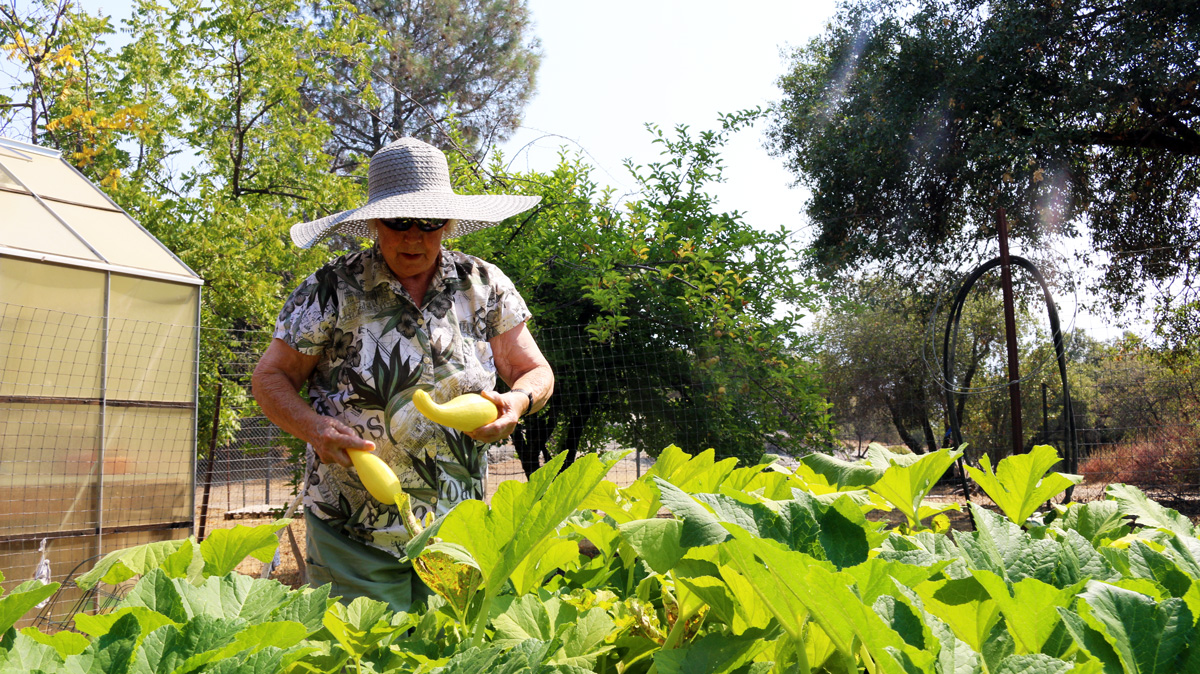
Smoke from wildfires is undermining decades of gains made in reducing air pollution from exhaust pipes and power plants. The number of days each year that wildfires foul the air is increasing in parts of the West, with worse expected as temperatures continue to rise.
Wildfires are projected to continue increasing in size and frequency, leading to more ‘smoke waves’ — days-long bouts of dangerous pollution. For asthmatics like Fisher, that means more days of lung-pinching pain and confinement indoors. For those who aren’t retired, it can mean missed work.
Someone exposed to smoke for a few weeks can feel health impacts long afterward, says Loretta Mickley, an atmospheric chemist at Harvard University who studies the relationship between smoke particles and health. In the longer term, exposure to the pollution is associated with earlier deaths.
“You might not automatically have a heart attack or get asthma,” Mickley said. “But health effects can last for a year or more.”
[contextly_sidebar id=”HWK9Tdsapvxh9XUBThIRFS0pCQet5a2x”]Fisher’s home is surrounded by forests that are naturally prone to burn, putting her at the front lines of smoke waves. Forty miles downhill, smoke from fires burning around California funnels into the Central Valley — a farming region where 6.5 million residents, many of them poor and working outdoors, endure some of the country’s most polluted air.
Since 2010, residents of the San Joaquin Valley, one of the two valleys that comprise the Central Valley, experienced at least 40 days each year when air quality was dangerous according to EPA standards.
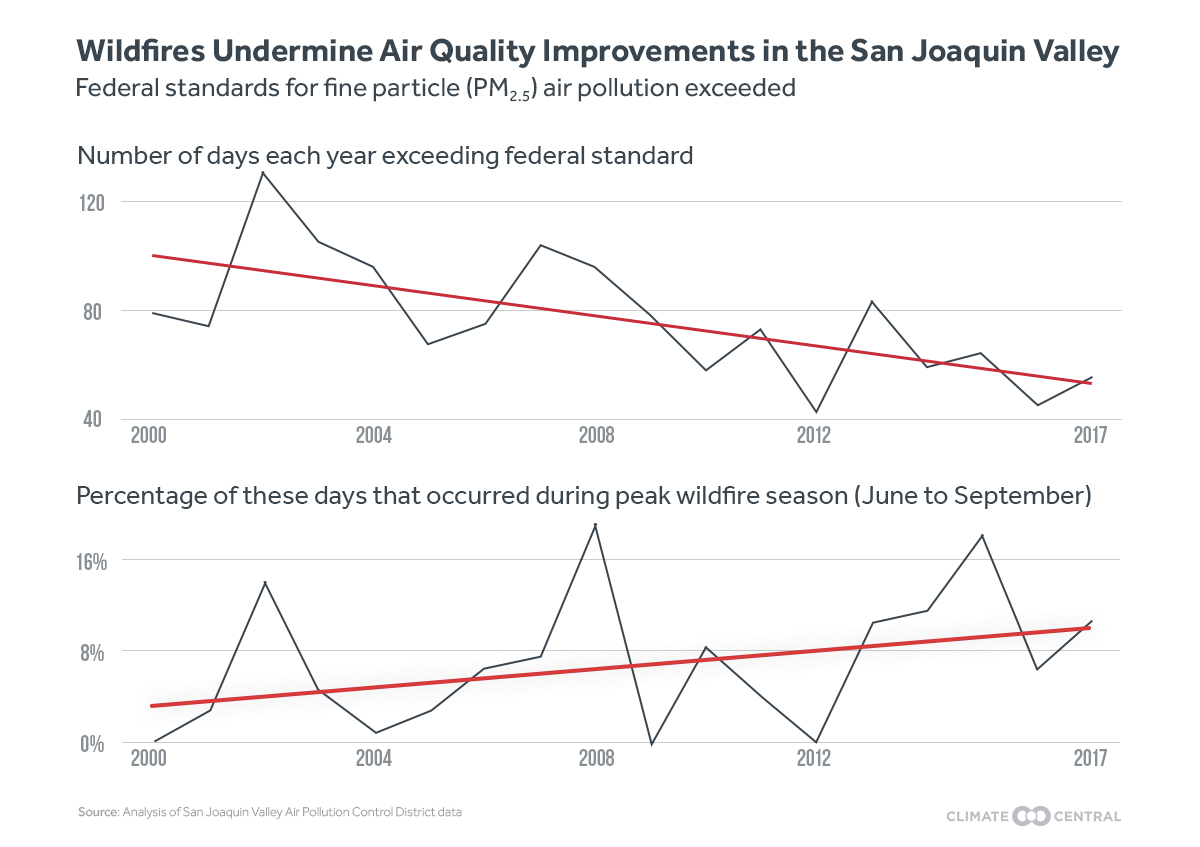 “We have the biggest challenge that any air district has in the nation,” said Jon Klassen, a program manager at the San Joaquin Valley Air Pollution Control District.
“We have the biggest challenge that any air district has in the nation,” said Jon Klassen, a program manager at the San Joaquin Valley Air Pollution Control District.
Amid advances in reducing pollution from farms and the trucks that haul away their produce, longer and larger wildfires burning throughout California are ushering more smoke waves into this hard-hit region. Rising temperatures, a build-up of fuel on forest floors and the growth of neighborhoods in fire-prone areas are amplifying hazards. With these wildfires, comes more smoke.
Residents of the Central Valley endure greater risks than others in the U.S. of developing asthma, suffering heart attacks and strokes, and experiencing related mental health problems. Health care costs follow. The smoke affects day-to-day activities, putting classes and sports practices on hold and keeping the sick and elderly indoors.
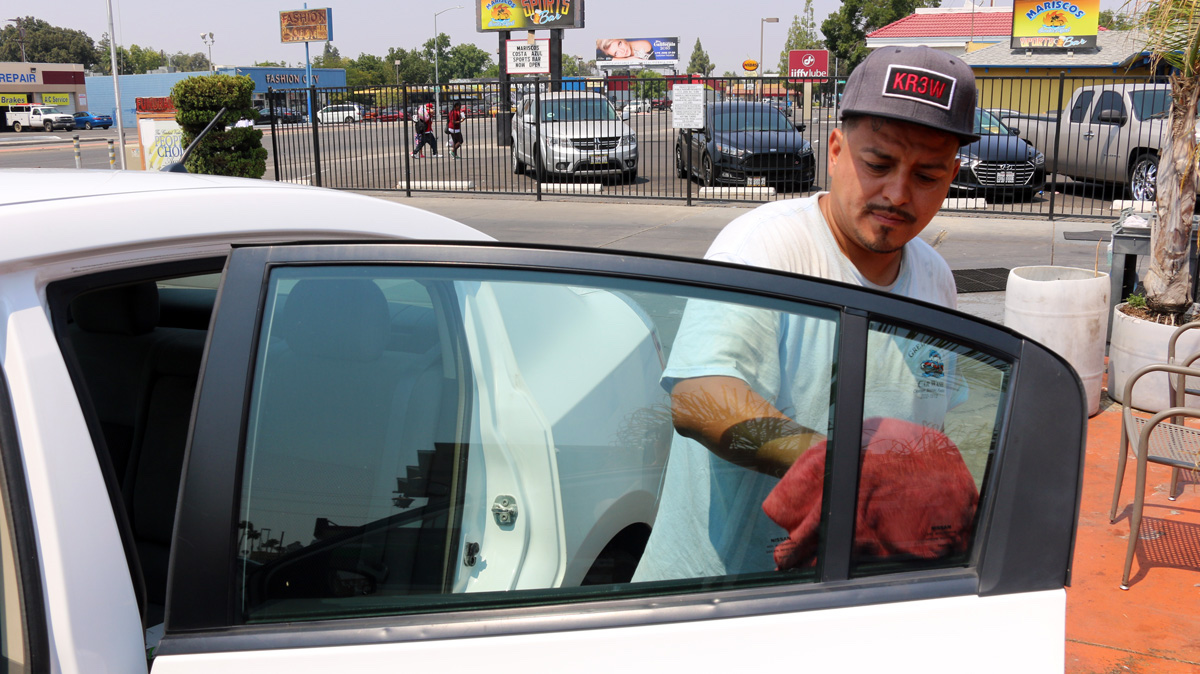
Dan Jaffe, a chemistry professor at the University of Washington, Bothell who studies air quality, analyzed data from air monitors. He found that since 1970, air quality on the most polluted days each year improved on average across much of the continental U.S. But it worsened across swaths of the West, including the northern half of California and other areas affected by smoke waves.
“There really has been a statistically robust increase in wildfires in the Western U.S., and that’s directly impacting air pollution,” Jaffe said.
Breathing Fire
Regina Sorondo was born and raised in Fresno, a San Joaquin Valley city home to 500,000 people. Now, she’s raising her daughter and son here. Like one in four children living in Fresno County, both have been diagnosed with asthma.
“Last season to this season has been really bad,” said Sorondo, a call center employee, of the smoke from record-breaking fire seasons. “It’s really dangerous — it’s really scary.”
The tiny particles in the smoke, released when fire burns through fuel, is what Sorondo worries about most. Small enough to sneak through defense systems in the eyes, nose and mouth, the particulate matter, called PM2.5, can pierce through the lungs and travel through the bloodstream to organs including the heart.
“Particulate matter does affect how our central nervous system works,” said Wayne Cascio, a cardiologist and lab director at the federal EPA who studies the topic. “It also has an effect on inflammation, which we now know is an important role in driving cardiovascular outcomes.”
Staying indoors for prolonged periods, which is one of the few ways of guarding against particulate matter, can affect mental health. The Oregon Health Authority is working to help people in the southern half of the state, where wildfire smoke from California has led to sustained exposure, find psychologists and therapists.
The veil of pollution clouding much of the West this summer comes with fatal consequences. A study published in GeoHealth this summer concluded that early deaths related to wildfire smoke could double this century, even as deaths from breathing fossil fuel pollution decline amid a transition to cleaner energy.
“You see more patients coming in with typical symptoms of shortness of breath, wheezing, chronic cough,“ said Praveen Buddiga, an asthma doctor who has been treating patients in Fresno for 13 years.
These particles don’t just affect people living close to burning wildfires. In the weeks after the Carr Fire broke out nearly 350 miles north of Fresno, Buddiga said there was an uptick in patients visiting his clinic — particularly children. Smoke from Western wildfires in early August reached far as Louisiana and New York.
“What’s been dramatic is how the smoke is traveling eastward,” said the EPA’s Cascio. “It’s not just a local phenomena, it’s a national one.”
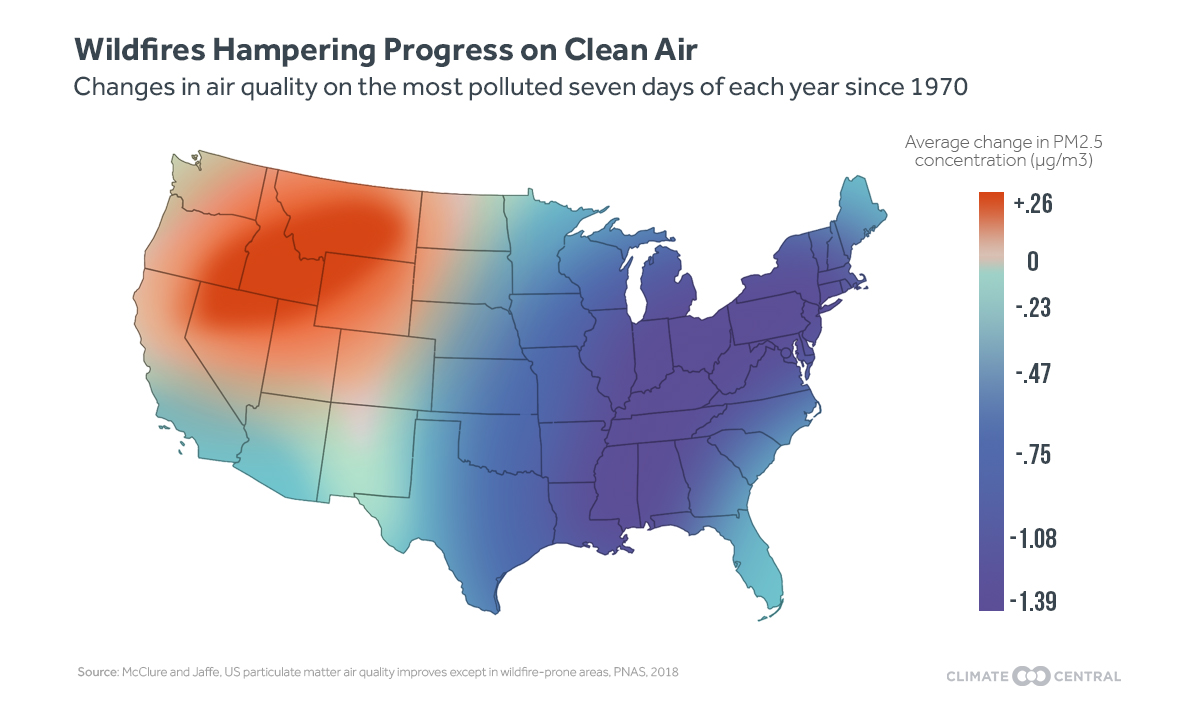 Reversing Decades of Air Quality Gains
Reversing Decades of Air Quality Gains
Since the 1990s, when monitors began tracking PM2.5 and the EPA began fining states for breaching its standards, air quality nationwide has been improving. The number of people exposed to particulate matter has halved, and related deaths have fallen by about a third, according to a study by the National Institutes of Health.
With wildfires increasing in size and intensity, those gains are being undermined.
Climate Central researchers examined the number of days each year when PM2.5 levels exceeded federal standards. In both of the valleys that comprise California’s Central Valley, the number of these days decreased overall since 2000, but the proportion of those days occurring during the wildfire season increased.
Health risks depend on age, health conditions and wealth. Poorer residents may not be able to miss work, and may live in drafty homes that allow smoke to permeate indoors.
Sheryl Magzamen, an epidemiologist at Colorado State University, has been tracking asthma-related hospital admissions in Western counties. At the beginning of August, as the Mendocino Complex Fire burned in northern California, she said she found that the likelihood of being hospitalized with asthma-related issues more than doubled along counties on the Oregon-California border.
“We breathe every minute of every day multiple times and it’s not something that we can stop doing,” said Magzamen. “That’s why this is concerning — this impacts everyone, it’s widespread and we’re seeing real impacts.”
The Role of Humans
Climate change, the whims of the weather and a century of firefighting practices have all been contributing to the destructiveness of the West’s recent wildfire seasons. Even as scientists and California firefighters point to the role of warming temperatures in fueling blazes, the Trump administration has been downplaying or falsely denying the links.
Rising temperatures in California caused in part by the heat-trapping effects of fossil fuel pollution are sucking moisture from Western landscapes and hastening the annual melting of snowpacks, drying fuel for wildfires.
“Fire responds exponentially to warming,” said Park Williams, a bioclimatologist at Columbia University. “For every degree of warming there is in the Western U.S., the impact is a lot more.”
Meanwhile, new residents continue to move into areas that are prone to burn, increasing risks to themselves, and accidentally or deliberately starting fires.
A century of aggressive firefighting to protect residents and property has also contributed to the devastation, leaving fuel on forest floors that would once have burned naturally during low-level fires kindled by lightning strikes.
Since a series of forest fires burned three million acres of Montana, Idaho and Washington in 1910, strategies for managing fires have generally favored extinguishing them as quickly as possible.
“We shouldn’t suppress all fires, they are part of our ecosystem and are necessary,” said Colleen Reid, a geographer at the University of Colorado-Boulder who is investigating how controlled burns and wildfires affect public health. “The challenge is having that perspective but also caring about the health of populations.”
In recent years, the federal government has been working with local and state agencies to boost prescribed burns, where officials set and manage low-level fires that consume shrubs, small trees and leaf litter. The efforts have been be limited by funding shortfalls. And nearby residents and local agencies sometimes oppose prescribed burns, worried about smoke pollution and risks that the fires will get out of control.
As the Trump administration eliminates climate protections and falsely denies climate change’s role in wildfires, it has proposed reduced spending to agencies researching and managing wildfires.
“When you’re spending $2.5 billion fighting forest fires, there’s not a lot left in the budget to do forest management,” Interior Secretary Ryan Zinke said in a radio interview Sunday with KCRA 3 in Sacramento. (During the interview, he incorrectly said this year’s wildfires have “nothing to do with climate change.”)
As federal government leaders reject basic science and move to shrink programs that could reduce risks, the air district that regulates air pollution in the San Joaquin Valley is becoming more flexible in allowing for prescribed burns — even when the air is already dirty.
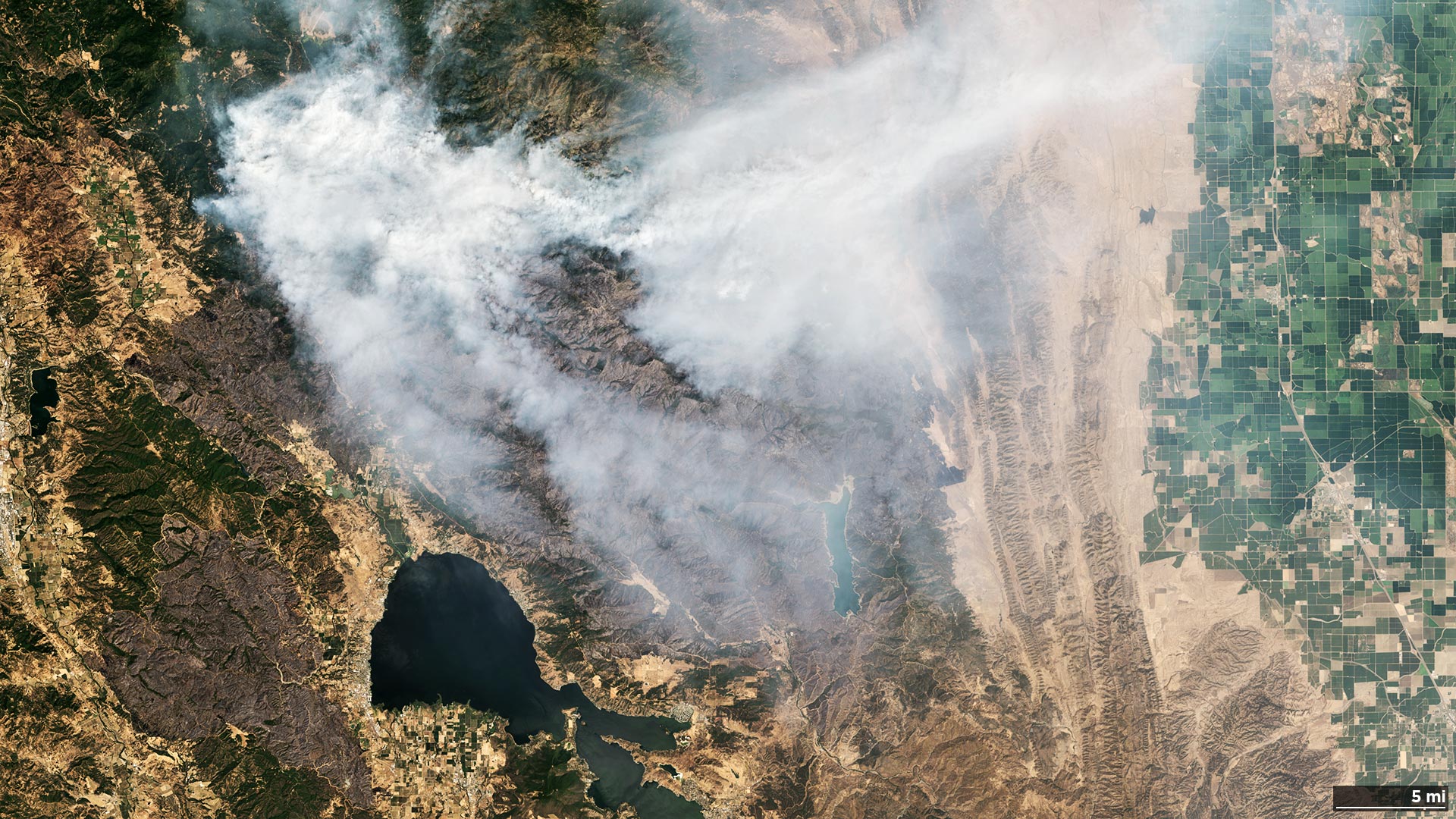
“We’ve had to go further than any region has before,” said Klassen, of the San Joaquin Valley’s air district. It has implemented hundreds of rules in an effort to reduce pollution, including allowing more prescribed burns in the region.
Still, AJ Rassamni, who manages a car wash in Fresno, wants to see more comprehensive forest management. With fewer people leaving their homes amid recent smoke waves, fewer customers have been coming through his car wash. He provides masks to protect staff, but they can make breathing difficult.
Worried about effects from climate change, Rassamni bought an electric car and had solar panels installed at home to reduce his climate pollution. Without aggressive steps from governments to systematically reduce pollution and boost prescribed burns, though, his efforts alone will do little to protect Central Valley residents.
“Is it good for us?” he said. “No. But you have a life, and you’re going to live with the weather you have.”
This story was produced and published in partnership with Climate Central, a non-advocacy group that researches and reports on the changing climate.
65 episoder
Fetch error
Hmmm there seems to be a problem fetching this series right now.
Last successful fetch was on February 27, 2024 02:59 (
What now? This series will be checked again in the next day. If you believe it should be working, please verify the publisher's feed link below is valid and includes actual episode links. You can contact support to request the feed be immediately fetched.
Manage episode 227726003 series 2486058
Worsening wildfires linked to the weather, climate change and forest management policies are causing unprecedented smoke pollution across the West and beyond, creating public health risks and undermining decades of air quality gains.
After 30 minutes of gardening, Donna Fisher’s eyes are burning. One is swollen shut. Since retiring to the forested foothills of the Sierra Nevada mountain range 20 years ago, the 74-year-old has cultivated a garden large enough to feed her and her husband well into the winter. For the past two years, smoke from wildfires has reduced the time she can spend tending to her vegetables before her asthma and bronchitis are triggered.
“It’s like somebody choking you, or putting a band around your chest and pulling it tight,” she said. Wildfire seasons in the Western U.S. are 105 days longer than they were five decades ago, billowing smoke that contains tiny chemical particles that threaten public health. “It used to be a few days, maybe a week at worse. Now it’s longer than it’s ever been.”

Smoke from wildfires is undermining decades of gains made in reducing air pollution from exhaust pipes and power plants. The number of days each year that wildfires foul the air is increasing in parts of the West, with worse expected as temperatures continue to rise.
Wildfires are projected to continue increasing in size and frequency, leading to more ‘smoke waves’ — days-long bouts of dangerous pollution. For asthmatics like Fisher, that means more days of lung-pinching pain and confinement indoors. For those who aren’t retired, it can mean missed work.
Someone exposed to smoke for a few weeks can feel health impacts long afterward, says Loretta Mickley, an atmospheric chemist at Harvard University who studies the relationship between smoke particles and health. In the longer term, exposure to the pollution is associated with earlier deaths.
“You might not automatically have a heart attack or get asthma,” Mickley said. “But health effects can last for a year or more.”
[contextly_sidebar id=”HWK9Tdsapvxh9XUBThIRFS0pCQet5a2x”]Fisher’s home is surrounded by forests that are naturally prone to burn, putting her at the front lines of smoke waves. Forty miles downhill, smoke from fires burning around California funnels into the Central Valley — a farming region where 6.5 million residents, many of them poor and working outdoors, endure some of the country’s most polluted air.
Since 2010, residents of the San Joaquin Valley, one of the two valleys that comprise the Central Valley, experienced at least 40 days each year when air quality was dangerous according to EPA standards.
 “We have the biggest challenge that any air district has in the nation,” said Jon Klassen, a program manager at the San Joaquin Valley Air Pollution Control District.
“We have the biggest challenge that any air district has in the nation,” said Jon Klassen, a program manager at the San Joaquin Valley Air Pollution Control District.
Amid advances in reducing pollution from farms and the trucks that haul away their produce, longer and larger wildfires burning throughout California are ushering more smoke waves into this hard-hit region. Rising temperatures, a build-up of fuel on forest floors and the growth of neighborhoods in fire-prone areas are amplifying hazards. With these wildfires, comes more smoke.
Residents of the Central Valley endure greater risks than others in the U.S. of developing asthma, suffering heart attacks and strokes, and experiencing related mental health problems. Health care costs follow. The smoke affects day-to-day activities, putting classes and sports practices on hold and keeping the sick and elderly indoors.

Dan Jaffe, a chemistry professor at the University of Washington, Bothell who studies air quality, analyzed data from air monitors. He found that since 1970, air quality on the most polluted days each year improved on average across much of the continental U.S. But it worsened across swaths of the West, including the northern half of California and other areas affected by smoke waves.
“There really has been a statistically robust increase in wildfires in the Western U.S., and that’s directly impacting air pollution,” Jaffe said.
Breathing Fire
Regina Sorondo was born and raised in Fresno, a San Joaquin Valley city home to 500,000 people. Now, she’s raising her daughter and son here. Like one in four children living in Fresno County, both have been diagnosed with asthma.
“Last season to this season has been really bad,” said Sorondo, a call center employee, of the smoke from record-breaking fire seasons. “It’s really dangerous — it’s really scary.”
The tiny particles in the smoke, released when fire burns through fuel, is what Sorondo worries about most. Small enough to sneak through defense systems in the eyes, nose and mouth, the particulate matter, called PM2.5, can pierce through the lungs and travel through the bloodstream to organs including the heart.
“Particulate matter does affect how our central nervous system works,” said Wayne Cascio, a cardiologist and lab director at the federal EPA who studies the topic. “It also has an effect on inflammation, which we now know is an important role in driving cardiovascular outcomes.”
Staying indoors for prolonged periods, which is one of the few ways of guarding against particulate matter, can affect mental health. The Oregon Health Authority is working to help people in the southern half of the state, where wildfire smoke from California has led to sustained exposure, find psychologists and therapists.
The veil of pollution clouding much of the West this summer comes with fatal consequences. A study published in GeoHealth this summer concluded that early deaths related to wildfire smoke could double this century, even as deaths from breathing fossil fuel pollution decline amid a transition to cleaner energy.
“You see more patients coming in with typical symptoms of shortness of breath, wheezing, chronic cough,“ said Praveen Buddiga, an asthma doctor who has been treating patients in Fresno for 13 years.
These particles don’t just affect people living close to burning wildfires. In the weeks after the Carr Fire broke out nearly 350 miles north of Fresno, Buddiga said there was an uptick in patients visiting his clinic — particularly children. Smoke from Western wildfires in early August reached far as Louisiana and New York.
“What’s been dramatic is how the smoke is traveling eastward,” said the EPA’s Cascio. “It’s not just a local phenomena, it’s a national one.”
 Reversing Decades of Air Quality Gains
Reversing Decades of Air Quality Gains
Since the 1990s, when monitors began tracking PM2.5 and the EPA began fining states for breaching its standards, air quality nationwide has been improving. The number of people exposed to particulate matter has halved, and related deaths have fallen by about a third, according to a study by the National Institutes of Health.
With wildfires increasing in size and intensity, those gains are being undermined.
Climate Central researchers examined the number of days each year when PM2.5 levels exceeded federal standards. In both of the valleys that comprise California’s Central Valley, the number of these days decreased overall since 2000, but the proportion of those days occurring during the wildfire season increased.
Health risks depend on age, health conditions and wealth. Poorer residents may not be able to miss work, and may live in drafty homes that allow smoke to permeate indoors.
Sheryl Magzamen, an epidemiologist at Colorado State University, has been tracking asthma-related hospital admissions in Western counties. At the beginning of August, as the Mendocino Complex Fire burned in northern California, she said she found that the likelihood of being hospitalized with asthma-related issues more than doubled along counties on the Oregon-California border.
“We breathe every minute of every day multiple times and it’s not something that we can stop doing,” said Magzamen. “That’s why this is concerning — this impacts everyone, it’s widespread and we’re seeing real impacts.”
The Role of Humans
Climate change, the whims of the weather and a century of firefighting practices have all been contributing to the destructiveness of the West’s recent wildfire seasons. Even as scientists and California firefighters point to the role of warming temperatures in fueling blazes, the Trump administration has been downplaying or falsely denying the links.
Rising temperatures in California caused in part by the heat-trapping effects of fossil fuel pollution are sucking moisture from Western landscapes and hastening the annual melting of snowpacks, drying fuel for wildfires.
“Fire responds exponentially to warming,” said Park Williams, a bioclimatologist at Columbia University. “For every degree of warming there is in the Western U.S., the impact is a lot more.”
Meanwhile, new residents continue to move into areas that are prone to burn, increasing risks to themselves, and accidentally or deliberately starting fires.
A century of aggressive firefighting to protect residents and property has also contributed to the devastation, leaving fuel on forest floors that would once have burned naturally during low-level fires kindled by lightning strikes.
Since a series of forest fires burned three million acres of Montana, Idaho and Washington in 1910, strategies for managing fires have generally favored extinguishing them as quickly as possible.
“We shouldn’t suppress all fires, they are part of our ecosystem and are necessary,” said Colleen Reid, a geographer at the University of Colorado-Boulder who is investigating how controlled burns and wildfires affect public health. “The challenge is having that perspective but also caring about the health of populations.”
In recent years, the federal government has been working with local and state agencies to boost prescribed burns, where officials set and manage low-level fires that consume shrubs, small trees and leaf litter. The efforts have been be limited by funding shortfalls. And nearby residents and local agencies sometimes oppose prescribed burns, worried about smoke pollution and risks that the fires will get out of control.
As the Trump administration eliminates climate protections and falsely denies climate change’s role in wildfires, it has proposed reduced spending to agencies researching and managing wildfires.
“When you’re spending $2.5 billion fighting forest fires, there’s not a lot left in the budget to do forest management,” Interior Secretary Ryan Zinke said in a radio interview Sunday with KCRA 3 in Sacramento. (During the interview, he incorrectly said this year’s wildfires have “nothing to do with climate change.”)
As federal government leaders reject basic science and move to shrink programs that could reduce risks, the air district that regulates air pollution in the San Joaquin Valley is becoming more flexible in allowing for prescribed burns — even when the air is already dirty.

“We’ve had to go further than any region has before,” said Klassen, of the San Joaquin Valley’s air district. It has implemented hundreds of rules in an effort to reduce pollution, including allowing more prescribed burns in the region.
Still, AJ Rassamni, who manages a car wash in Fresno, wants to see more comprehensive forest management. With fewer people leaving their homes amid recent smoke waves, fewer customers have been coming through his car wash. He provides masks to protect staff, but they can make breathing difficult.
Worried about effects from climate change, Rassamni bought an electric car and had solar panels installed at home to reduce his climate pollution. Without aggressive steps from governments to systematically reduce pollution and boost prescribed burns, though, his efforts alone will do little to protect Central Valley residents.
“Is it good for us?” he said. “No. But you have a life, and you’re going to live with the weather you have.”
This story was produced and published in partnership with Climate Central, a non-advocacy group that researches and reports on the changing climate.
65 episoder
Alla avsnitt
×Välkommen till Player FM
Player FM scannar webben för högkvalitativa podcasts för dig att njuta av nu direkt. Den är den bästa podcast-appen och den fungerar med Android, Iphone och webben. Bli medlem för att synka prenumerationer mellan enheter.




